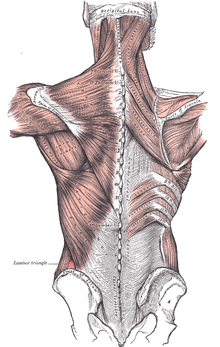| Petit's hernia | |
|---|---|
 | |
| Posterior view of muscles connecting the upper extremity to the vertebral column. Inferior lumbar triangle is labeled in red at bottom left. | |
| Specialty | Gastroenterology |
Petit's hernia is a hernia that protrudes through the lumbar triangle (aka Petit's triangle).[1] This triangle lies in the posterolateral abdominal wall and is bounded anteriorly by the free margin of external oblique muscle, posteriorly by the latissimus dorsi and inferiorly by the iliac crest. The neck (the spot where the hernia protrudes into the opening) is large, and therefore this hernia has a lower risk of strangulating than some other hernias.
Petit's hernia occurs more often in males than in females[2] and more often on the left side than on the right.
See also[edit]
References[edit]
- ^ Lawrence, Peter F.; Bell, Richard M.; Dayton, Merril T.; Hebert, James (2013). Essentials of General Surgery. Lippincott Williams & Wilkins. p. 215. ISBN 9781469837291. Retrieved 7 March 2018.
- ^ Feldman, Mark; Friedman, Lawrence S.; Brandt, Lawrence J. (2010). Sleisenger and Fordtran's Gastrointestinal and Liver Disease E-Book: Pathophysiology, Diagnosis, Management, Expert Consult Premium Edition - Enhanced Online Features. Elsevier Health Sciences. p. 392. ISBN 978-1437727678. Retrieved 7 March 2018.
Well, that’s interesting to know that Psilotum nudum are known as whisk ferns. Psilotum nudum is the commoner species of the two. While the P. flaccidum is a rare species and is found in the tropical islands. Both the species are usually epiphytic in habit and grow upon tree ferns. These species may also be terrestrial and grow in humus or in the crevices of the rocks.
View the detailed Guide of Psilotum nudum: Detailed Study Of Psilotum Nudum (Whisk Fern), Classification, Anatomy, Reproduction